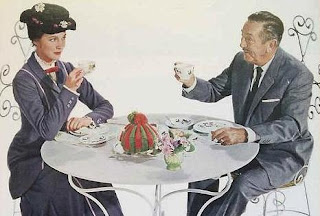So what do I mean by Place? Consider the previous analogy, where Purpose is potency and Passion is romance. After all this sweaty-palms stuff, what do you have left?
For a lot of people, the answer is a resounding "nothing." But for others, this answer is, well,
something--a relationship. It usually isn't what you'd expect. Maybe it's a lifetime of resentment and misery, or a quiet sort of contentment. For a lucky few, it's a neverending good time.
Inevitably, if there is a "relationship," the people involved find their
place. In much the same way, great attractions find their Place too.
Place isn't about location, though location certainly plays a role. Take Rock City, for example. Located in Chattanooga, TN, this is one of those quintessential American establishments, a mom-and-pop roadside attraction that opened in 1932, in the midst of the Great Depression.
Rock City: High Atop Lookout Mountain
Back in its early days, Rock City was a scenic stop that included a hike to the top of Lookout Mountain, where Frieda Carter (wife of Garnet Carter, inventor of Tom Thumb Golf) had created a bucolic trek through natural and contrived rock formations. From this vantage point visitors could purportedly "see seven states."
Blame Global Warming...the most I've ever seen is four!
Rock City is picturesque, idiosyncratic, and a work of love. But plenty of attractions have the same attributes. What sets Rock City apart--what gives it Place--is the way it has positioned itself as this quirky, curious stop along I-75. It seems like everyone has heard of it. For some reason Rock City rises above other highway diversions.
Why? It's hard to tell. Certainly part of it is attributable to the 70-year old campaign of painting barns across the USA with the famous "See Rock City" slogan. But as importantly, Rock City delivered the goods for all those people who ventures from the Interstate...the anxious moms, the weary dads, all those high-strung kids who had been pent up in cars for hours on end, even the grandmas looking for birdfeeders and souvenir spoons.
One of the most successful marketing campaigns: The Rock City Barn!
What does it deliver? Rock City is a sweet, almost anachronistic oasis from the stress of highway travel. As it has grown, its retained its eccentricity. Nestled among Frieda's original rock garden are caverns with weird 50's-era day-glo storybook scenes. Ladies dressed like Mother Goose greet kids and a robot gnome acts as a barker at the entrance. For the Northerners making the pilgrimage to (or from) Orlando, this is the anti-Disney, devoid of corporate artifice and brand promotion. It just feels honest.
That's the Place that Rock City occupies. It's not just that it's a welcome respite from the noise. Rock City is trusted and it delivers
. Folks know going in that this place has served generations of travelers
just like them.
Circling back on the "Pee #1 -Purpose" post, we have Disneyland. You can argue that the Purpose of this attraction has drifted from Walt's original family park vision and today is something less certain, less definable. To many, Disneyland appears to have consciously violated its founding principle, adding big-budget thrill rides that deliberately split the family, forcing short guests, frail guests, and timid guests into backwater attractions.
Disneyland's Grad Nite--a tame but non-family affair--appeared in 1961.
Though some folks may think that such criticism is unfair, Disneyland's Purpose isn't entirely obvious. That said, Disneyland's PLACE is cemented. It is this
legacy attraction. It has entertained millions of people for almost six decades. It is safe. It is all-American. For many families with kids, it is a rite of passage. For locals, it is almost like a neighborhood attraction, a place to go with friends or on a date. For people around the world, Disneyland is a place they trust (even if they don't trust the country it is located in), a place where they expect to be entertained in ways no one else can. Disneyland is an American landmark.
Place is about the relationship an attraction has with its audience. A Great Attraction successfully defines that relationship and in the process creates its Place.
Many attractions fail because the relationship they set out to create never takes hold. Like some lovelorn teenager, their efforts go unacknowledged.
Other attractions, with a history of success and an established Place, attempt to redefine the relationship, upping the ante, showing up one afternoon with a toothbrush and asking for a key to their girlfriend's apartment.
Sometimes this works, as it did when Walt Disney World added its EPCOT Center in 1982, hoping and praying that guests would be hungry for another day of Disney theme park-ing. That gamble resulted in the Mouse's Florida property becoming a multi-day destination in the minds of folks who otherwise considered the Magic Kingdom a drop-in-for-a-day park.
It seems that just as often, an attempt to redefine Place is refused by the audience. Disney's attempt to repeat its Florida success with the addition of Disney's California Adventure is an easy example. But it can certainly happen on a more local scale.
Consider COSI from "Pee#2 - Passion." This was a joint that was loved in its community. But a high-profile move into a colossal Arata Isozaki building, a completely new collection of whiz-bang exhibits, and (perhaps most importantly) a 60% increase in admission costs resulted in a huge backlash. The folks that COSI had established a relationship with didn't know what to expect from this new thing. It took COSI the better part of a decade to recast that relationship with a newfound commitment to partnerships with local and regional organizations who share a common purpose.
Establishing an attraction's Place is not easy, but it is essential to Greatness. Once that Place is found, it can still be bobbled and lost.








